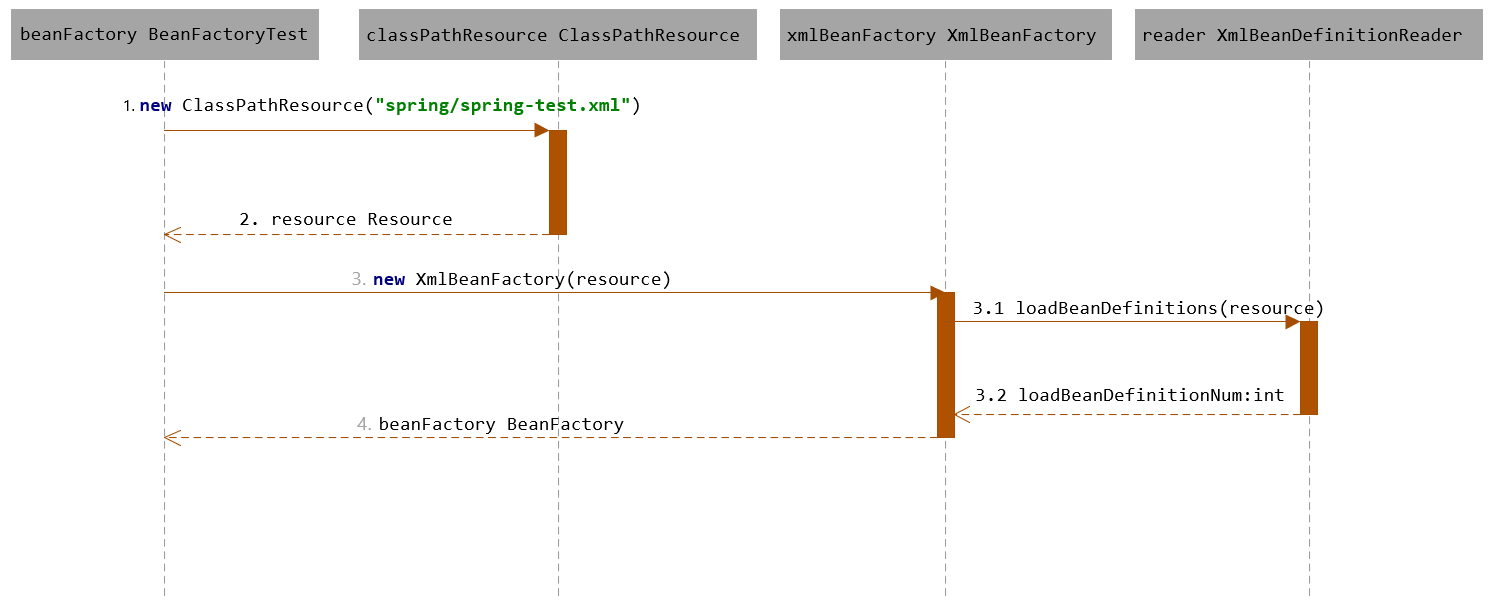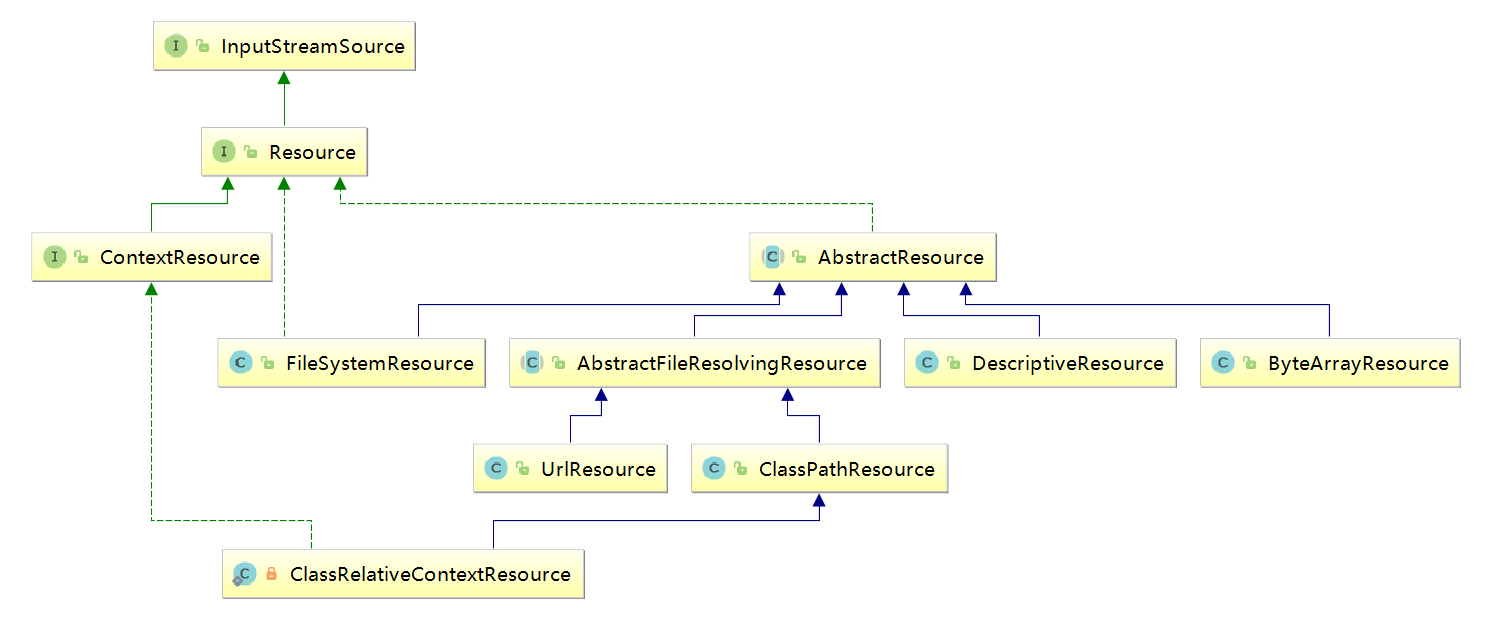在正式分析Spring源码之前,我们有必要先来回顾一下Spring中最简单的用法。尽管我相信您已经对这个例子非常熟悉了。
Bean是Spring中最核心的概念,因为Spring就像是个大水桶,而Bean就像是水桶中的水,水桶脱离了水也就没什么用处了,那么我们先看看Bean的定义。
public class MySpringBean {
private String str = "mySpringBean";
public String getStr() {
return str;
}
public void setStr(String str) {
this.str = str;
}
}
很普通,Bean没有任何特别之处。的确,Spring的目的就是让我们的Bean能成为一个纯粹的POJO,这也是Spring所追求的。接下来看看配置文件:
<?xml version="1.0" encoding="UTF-8"?>
<beans xmlns="http://www.springframework.org/schema/beans"
xmlns:xsi="http://www.w3.org/2001/XMLSchema-instance"
xsi:schemaLocation="http://www.springframework.org/schema/beans
http://www.springframework.org/schema/beans/spring-beans.xsd">
<bean id="mySpringBean" class="org.cellphone.uc.MySpringBean"/>
</beans>
在上面的配置中我们看到了Bean的声明方式,接下来看测试代码:
public class BeanFactoryTest {
@Test
public void testSimpleLoad() {
BeanFactory beanFactory = new XmlBeanFactory(new ClassPathResource("spring/spring-test.xml"));
MySpringBean bean = (MySpringBean) beanFactory.getBean("mySpringBean");
Assert.assertEquals("testSimpleLoad", "mySpringBean", bean.getStr());
}
}
XmlBeanFactory从Spring 3.1版本开始就被废弃了,但源码中未说明废弃的原因......
直接使用BeanFactory作为容器对于Spring的使用来说并不多见,因为在企业级的应用中大多数都会使用ApplicationContext(后续再介绍两者之间的差异),这里只是用于测试,让读者更快更好地分析Spring的内部原理。
通过上面一行简单的代码就拿到了MySpringBean实例,但这行代码在Spring中却执行了非常多的逻辑。接下来就来深入分析BeanFactory.getBean方法的实现原理
在上一篇文章中,我们熟悉了容器的基本用法。在这一篇,我们开始分析Spring的源码。但是在正式开始熟悉源码之前,有必要了解一下Spring中最核心的两个类。
1. DefaultListableBeanFactory
XmlBeanFactory继承自DefaultListableBeanFactory,而DefaultListableBeanFactory是整个bean加载的核心部分,是Spring注册及加载bean的默认实现,而对于XmlBeanFactory与DefaultListableBeanFactory不同的地方其实是在XmlBeanFactory中使用了自定义的XML读取器XmlBeanDefinitionReader,实现了个性化的BeanDefinitionReader读取,DefaultListableBeanFactory继承了AbstractAutowireCapableBeanFactory并实现了ConfigurableListableBeanFactory以及BeanDefinitionRegistry接口。以下是DefaultListableBeanFactory的类图:

从上面的类图中,我们可以清晰地从全局角度了解DefaultListableBeanFactory的脉络。接下来先了解一下上面类图中各个类的作用。
| AliasRegistry | 定义对alias的简单增删改查等操作 |
| SimpleAliasRegistry | 主要使用map作为alias的缓存,并对接口AliasRegistry进行实现 |
| SingletonBeanRegistry | 定义对单例的注册及获取 |
| BeanFactory | 定义获取bean及bean的各种属性 |
| DefaultSingletonBeanFactory | 对接口SingletonBeanRegistry各函数的实现 |
| HierarchicalBeanFactory | 继承BeanFactory,也就是在BeanFactory定义的功能的基础上增加了对parentFactory的支持 |
| BeanDefinitionRegistry | 定义对BeanDefinition的各种增删改操作 |
| FactoryBeanRegistrySupport | 在DefaultSingletonBeanRegistry的基础上增加了对FactoryBean的特殊处理功能 |
| ConfigurableBeanFactory | 提供配置Factory的各种方法 |
| ListableBeanFactory | 根据各种条件获取bean的配置清单 |
| AbstractBeanFactory | 综合FactoryBeanRegistrySupport和ConfigurableBeanFactory的功能 |
| AutowireCapableBeanFactory | 提供创建bean、自动注入,初始化以及应用bean的后处理器 |
| AbstractAutowireCapableBeanFactory | 综合AbstractBeanFactory并对接口AutowireCapableBeanFactory进行实现 |
| ConfigurableListableBeanFactory | BeanFactory配置清单,指定忽略类型及接口等 |
| DefaultListableBeanFactory | 综合上面所有功能,主要是对Bean注册后的处理 |
XmlBeanFactory对DefaultListableBeanFactory进行了扩展,主要用于从XML文档中读取BeanDefinition,对于注册及获取Bean都是使用从父类DefaultListableBeanFactory继承的方法去实现,而唯独与父类不同的个性化实现就是增加了XmlBeanDefinitionReader类型的reader属性。在XmlBeanFactory中主要使用reader属性对资源文件进行读取和注册。
2. XmlBeanDefinitionReader
XML配置文件的读取时Spring的重要功能,因为Spring的大部分功能都是以配置作为切入点的,那么我们可以从XmlBeanDefinitionReader中梳理一下资源文件读取、解析及注册的大致脉络。首先我们看看各个类的功能。
| ResourceLoader | 定义资源加载器,主要应用于根据给定的资源文件地址返回对应的Resource |
| BeanDefinitionReader | 主要定义资源文件读取并转换为BeanDefinition的各个功能 |
| EnvironmentCapable | 定义获取Environment方法 |
| DocumentLoader | 定义从资源文件加载到转换为Document的功能 |
| AbstractBeanDefinitionReader | 对EnvironmentCapable、BeanDefinitionReader类定义的功能进行实现 |
| BeanDefinitionDocumentReader | 定义读取Document并注册BeanDefiniton功能 |
| BeanDefinitionParserDelegate | 定义解析Element的各种方法 |
通过以上分析,我们可以梳理出整个XML配置文件读取的大致流程,如下图所示:

在XmlBeanDifinitonReader中主要包含以下几个步骤的处理:
1)通过继承自AbstractBeanDefinitionReader中的方法,来使用ResourceLoader将资源文件路径转换为对应的Resource文件。
2)通过DocumentLoader对Resource文件进行转换,将Resource文件转换为Document文件。
3)通过实现接口BeanDefinitionDocumentReader的DefaultBeanDefinitionDocumentReader类对Document进行解析,并使用BeanDefinitionParserDelegate对Element进行解析。
经过Spring源码分析(二)容器基本用法和Spring源码分析(三)容器核心类两篇文章,我们已经对Spring的容器功能有了一个大致的了解,尽管你可能还很迷糊,但是不要紧,接下来我们会详细探索每个步骤的实现。首先要深入分析的是以下功能的代码实现:
BeanFactory beanFactory = new XmlBeanFactory(new ClassPathResource("spring/spring-test.xml"));
通过XmlBeanFactory初始化时序图,我们看下上面代码的执行逻辑:

时序图从BeanFactoryTest测试类开始,通过时序图我们可以一目了然地看到整个逻辑处理顺序。先调用了ClassPathResource的构造函数来构造Resource资源文件的实例对象,后续的资源处理就可以用Resource提供的各种服务来操作了,当我们有了Resource后就可以进行XmlBeanFactory的初始化了。那么Resource文件是如何封装的呢?
1. 配置文件封装
Spring的配置文件读取是通过ClassPathResource进行封装的,如new ClassPathResource("spring/spring-test.xml"),那么ClassPathResource完成了什么功能呢?
在Java中,将不同来源的资源抽象成URL,通过注册不同的handler(URLStreamHander)来处理不同来源的资源的读取逻辑,一般handler的类型使用不同的前缀(协议,Protocol)来识别,如“file:”、"http:"、"jar:"等,然而URL没有默认定义相对Classpath或ServletContext等资源的handler,虽然可以注册自己的URLStreamHandler来解析特定的URL前缀(协议),比如“classpath:”,然而这需要了解URL的实现机制,而且URL也没有提供一些基本的方法,如检查当前资源是否存在、检查当前资源是否可读等方法。因而Spring对其内部使用到的资源实现了自己的抽象结构:Resource接口来封装底层资源。
public interface InputStreamSource {
InputStream getInputStream() throws IOException;
}
public interface Resource extends InputStreamSource {
boolean exists();
default boolean isReadable() {
return true;
}
default boolean isOpen() {
return false;
}
default boolean isFile() {
return false;
}
URL getURL() throws IOException;
URI getURI() throws IOException;
File getFile() throws IOException;
default ReadableByteChannel readableChannel() throws IOException {
return Channels.newChannel(getInputStream());
}
long contentLength() throws IOException;
long lastModified() throws IOException;
Resource createRelative(String relativePath) throws IOException;
@Nullable
String getFilename();
String getDescription();
}
InputStreamSource封装任何能返回InputStream的类,比如File、Classpath下的资源和Byte Array等。它只有一个方法定义:getInputStream(),该方法返回一个新的InputStream对象。
Resource接口抽象了所有Spring内部使用到的底层资源:File、URL、Classpath等。首先,它定义了3个判断当前资源状态的方法:存在性(exists)、可读性(isReadable)、是否处于打开状态(isOpen)。另外,Resource接口还提供了不同资源到URL、URI、File类型的转换,以及获取lastModified属性、文件名(不带文件信息的文件名,getFilename())的方法。为了便于操作,Resource还提供了基于当前资源创建一个相对资源的方法:createRelative()。在错误处理中需要详细地打印出错的资源文件,因而Resource还提供了getDescription()方法用于在错误处理中的打印信息。
对不同来源的资源文件都有相应的Resource实现:文件(FileSystemResource)、Classpath资源(ClasspathResource)、URL资源(URLResource)、InputStream资源(InputStreamResource)、Byte数组(ByteArrayResource)等。相关类图如下图所示:

在日常的开发工作中,资源文件的加载也是经常用到的,可以直接使用Spring提供的类,比如在希望加载文件时可以使用以下代码:
Resource resource = new ClassPathResource("spring/spring-test.xml.xml");
InputStream inputStream = resource.getInputStream();
得到inputStream后,我们可以按照以前的开发方式进行实现了,并且我们已经可以利用Resource及其子类为我们提供好的诸多特性。
有了Resource接口便可以对所有资源文件进行统一处理。至于实现,其实是非常简单的,以getInputStream为例,ClassPathResource中的实现方式便是通过class或者classLoader提供的底层方法进行调用,而对于FileSystemResource的实现其实更简单,直接使用FileInputStream对文件进行实例化。
ClassPathResource.java
/**
* This implementation opens an InputStream for the given class path resource.
* @see java.lang.ClassLoader#getResourceAsStream(String)
* @see java.lang.Class#getResourceAsStream(String)
*/
@Override
public InputStream getInputStream() throws IOException {
InputStream is;
if (this.clazz != null) {
is = this.clazz.getResourceAsStream(this.path);
}
else if (this.classLoader != null) {
is = this.classLoader.getResourceAsStream(this.path);
}
else {
is = ClassLoader.getSystemResourceAsStream(this.path);
}
if (is == null) {
throw new FileNotFoundException(getDescription() + " cannot be opened because it does not exist");
}
return is;
}
FileSystemResource.java
/**
* This implementation opens a NIO file stream for the underlying file.
* @see java.io.FileInputStream
*/
@Override
public InputStream getInputStream() throws IOException {
try {
return Files.newInputStream(this.file.toPath());
}
catch (NoSuchFileException ex) {
throw new FileNotFoundException(ex.getMessage());
}
}
当通过Resource相关类完成了对配置文件进行封装后配置文件的读取工作就全权交给XmlBeanDefinitionReader来处理了。
了解了Spring中将配置文件封装为Resource类型的实例方法后,我们就可以继续探讨XmlBeanFactory的初始化方法了,XmlBeanFactory初始化有许多方法,Spring中提供了很多的构造函数,在这里分析的是使用Resource实例作为构造函数参数的方法,代码如下:
/**
* Create a new XmlBeanFactory with the given resource,
* which must be parsable using DOM.
* @param resource the XML resource to load bean definitions from
* @throws BeansException in case of loading or parsing errors
*/
public XmlBeanFactory(Resource resource) throws BeansException {
// 调用XmlBeanFactory(Resource resource, BeanFactory parentBeanFactory)构造方法
this(resource, null);
}
/**
* Create a new XmlBeanFactory with the given input stream,
* which must be parsable using DOM.
* @param resource the XML resource to load bean definitions from
* @param parentBeanFactory parent bean factory
* @throws BeansException in case of loading or parsing errors
*/
// parentBeanFactory为父类BeanFactory用于factory合并,可以为空
public XmlBeanFactory(Resource resource, BeanFactory parentBeanFactory) throws BeansException {
super(parentBeanFactory);
this.reader.loadBeanDefinitions(resource);
}
上面函数的代码中,this.reader.loadBeanDefinitions(resource)才是资源加载的真正实现,也是我们分析的重点之一。我们可以看到时序图中提到的XmlBeanDefinitionReader加载数据就是这里完成的,但是在XmlBeanDefinitionReader加载数据前还有一个调用父类构造函数初始化的过程:super(parentBeanFactory),跟踪代码到父类AbstractAutowireCapableBeanfactory的构造函数中:
/**
* Create a new AbstractAutowireCapableBeanFactory.
*/
public AbstractAutowireCapableBeanFactory() {
super();
ignoreDependencyInterface(BeanNameAware.class);
ignoreDependencyInterface(BeanFactoryAware.class);
ignoreDependencyInterface(BeanClassLoaderAware.class);
}
这里有必要提及下ignoreDependencyInterface方法。ignoreDependencyInterface的主要功能,是忽略给定接口的自动装配功能,那么,这样做的目的是什么呢?会产生什么样的效果呢?
举例来说,当A中有属性B,那么当Spring在获取A的Bean的如果其属性B还没有初始化,那么Spring会自动初始化B,这也是Spring提供的一个重要特性。但是,某些情况下B不会被初始化,其中的一种情况就是B实现了BeanNameAware接口。Spring中是这样介绍的,自动装配的时候,忽略给定的依赖接口,典型的应用是通过其他方式解析Application上下文注册依赖,类似于BeanFactory通过BeanFactoryAware进行注入或者ApplicationContext通过ApplicationContextAware进行注入。
2. 加载Bean
之前提到的在XmlBeanFactory构造函数中调用了XmlBeanDefinitionReader类型的reader属性提供的方法this.reader.loadBeanDefinitions(resource),而这句代码则是整个资源加载的切入点,我们先来看看这个方法的时序图,如下图所示:

看到上图我们才知道,原来绕了这么久还没有切入正题,还一直在为加载XML文件和解析注册Bean在做准备工作。从上面的时序图中我们尝试梳理整个的处理过程如下:
- 封装资源文件。当进入XmlBeanDefinitionReader后首先对参数Resource使用EncodeResource类进行封装。
- 获取输入流。从Resource中获取对应的InputStream并构造InputSource。
- 通过构造的InputSource实例和Resource实例继续调用函数doLoadBeanDefinitions。
我们来看一下loadBeanDefinitions函数具体的实现过程:
/**
* Load bean definitions from the specified XML file.
* @param resource the resource descriptor for the XML file
* @return the number of bean definitions found
* @throws BeanDefinitionStoreException in case of loading or parsing errors
*/
@Override
public int loadBeanDefinitions(Resource resource) throws BeanDefinitionStoreException {
return loadBeanDefinitions(new EncodedResource(resource));
}
那么EncodeResource的作用是什么呢?通过名称,我们可以大致推断这个类主要是用于对资源文件的编码进行处理。其中的主要逻辑体现在getReader()方法中,当设置了编码属性的时候Spring会使用相应的编码作为输入流的编码。
/**
* Open a {@code java.io.Reader} for the specified resource, using the specified
* {@link #getCharset() Charset} or {@linkplain #getEncoding() encoding}
* (if any).
* @throws IOException if opening the Reader failed
* @see #requiresReader()
* @see #getInputStream()
*/
public Reader getReader() throws IOException {
if (this.charset != null) {
return new InputStreamReader(this.resource.getInputStream(), this.charset);
}
else if (this.encoding != null) {
return new InputStreamReader(this.resource.getInputStream(), this.encoding);
}
else {
return new InputStreamReader(this.resource.getInputStream());
}
}
上面代码构造了一个有编码(encoding)的InputStreamReader。当构造好encodeResource对象后,再次转入了可复用方法loadBeanDefinitions(new EncodedResource(resource))。
这个方法内部才是真正的数据准备阶段,也就是时序图锁描述的逻辑:
public int loadBeanDefinitions(EncodedResource encodedResource) throws BeanDefinitionStoreException {
Assert.notNull(encodedResource, "EncodedResource must not be null");
if (logger.isDebugEnabled()) {
logger.debug("Loading XML bean definitions from " + encodedResource.getResource());
}
// 通过属性来记录已经加载的资源
Set<EncodedResource> currentResources = this.resourcesCurrentlyBeingLoaded.get();
if (currentResources == null) {
currentResources = new HashSet<>(4);
this.resourcesCurrentlyBeingLoaded.set(currentResources);
}
if (!currentResources.add(encodedResource)) {
throw new BeanDefinitionStoreException(
"Detected cyclic loading of " + encodedResource + " - check your import definitions!");
}
try {
// 从encodedResource中获取已经封装的Resource对象并再次从Resource中获取其中的inputStream
InputStream inputStream = encodedResource.getResource().getInputStream();
try {
// InputSource这个类并不是来自于Spring,他的全路径是org.xml.sax.InputSource
InputSource inputSource = new InputSource(inputStream);
if (encodedResource.getEncoding() != null) {
inputSource.setEncoding(encodedResource.getEncoding());
}
// 真正进入了逻辑核心部分
return doLoadBeanDefinitions(inputSource, encodedResource.getResource());
}
finally {
// 关闭输入流
inputStream.close();
}
}
catch (IOException ex) {
throw new BeanDefinitionStoreException(
"IOException parsing XML document from " + encodedResource.getResource(), ex);
}
finally {
currentResources.remove(encodedResource);
if (currentResources.isEmpty()) {
this.resourcesCurrentlyBeingLoaded.remove();
}
}
}
我们再次准备一下数据准备阶段的逻辑,首先对传入的resource参数做封装,目的是考虑到Resource可能存在编码要求的情况,其次,通过SAX读取XML文件的方式来准备InputSource对象,最后将准备的数据通过参数传入真正的核心处理部分doLoadBeanDefinitions(inputSource, encodedResource.getResource())。
protected int doLoadBeanDefinitions(InputSource inputSource, Resource resource)
throws BeanDefinitionStoreException {
try {
Document doc = doLoadDocument(inputSource, resource);
return registerBeanDefinitions(doc, resource);
}
catch (BeanDefinitionStoreException ex) {
throw ex;
}
catch (SAXParseException ex) {
throw new XmlBeanDefinitionStoreException(resource.getDescription(),
"Line " + ex.getLineNumber() + " in XML document from " + resource + " is invalid", ex);
}
catch (SAXException ex) {
throw new XmlBeanDefinitionStoreException(resource.getDescription(),
"XML document from " + resource + " is invalid", ex);
}
catch (ParserConfigurationException ex) {
throw new BeanDefinitionStoreException(resource.getDescription(),
"Parser configuration exception parsing XML from " + resource, ex);
}
catch (IOException ex) {
throw new BeanDefinitionStoreException(resource.getDescription(),
"IOException parsing XML document from " + resource, ex);
}
catch (Throwable ex) {
throw new BeanDefinitionStoreException(resource.getDescription(),
"Unexpected exception parsing XML document from " + resource, ex);
}
}
上面的代码只做了两件事,每一件都是必不可少的。
- 加载XML文件,并得到对应的Document。
- 根据返回的Document注册Bean信息。
这两个步骤支撑着整个Spring容器部分的实现基础,尤其是第二部对配置文件的解析,逻辑非常复杂,下一节里面先从获取Document讲起。
这一篇开始进行Document加载了,XmlBeanFactoryReader类对于文档读取并没有亲历亲为,而是委托给了DocumentLaoder去执行,DocumentLoader是个接口,真正调用的是DefaultDocumentLoader,解析代码如下:
/**
* Load the {@link Document} at the supplied {@link InputSource} using the standard JAXP-configured
* XML parser.
*/
@Override
public Document loadDocument(InputSource inputSource, EntityResolver entityResolver,
ErrorHandler errorHandler, int validationMode, boolean namespaceAware) throws Exception {
DocumentBuilderFactory factory = createDocumentBuilderFactory(validationMode, namespaceAware);
if (logger.isDebugEnabled()) {
logger.debug("Using JAXP provider [" + factory.getClass().getName() + "]");
}
DocumentBuilder builder = createDocumentBuilder(factory, entityResolver, errorHandler);
return builder.parse(inputSource);
}
对于这部分代码其实并没有太多可以描述的,因为通过SAX解析XML文档的套路都差不多,Spring在这里并没有什么特殊的地方,同样首先创建DocumentBuilderFactory,再通过DocumentBuilderFactory创建DocumentBuilder,进而解析inputSource来返回Document对象。这里有必要提及一下EntityResolver,对于参数entityResolver,传入的是通过getEntityResolver() 函数获取的返回值,如下代码:
protected EntityResolver getEntityResolver() {
if (this.entityResolver == null) {
// Determine default EntityResolver to use.
ResourceLoader resourceLoader = getResourceLoader();
if (resourceLoader != null) {
this.entityResolver = new ResourceEntityResolver(resourceLoader);
}
else {
this.entityResolver = new DelegatingEntityResolver(getBeanClassLoader());
}
}
return this.entityResolver;
}
那么,EntityResolver到底是做什么用的呢?
EntityResolver用法
在loadDocument方法中涉及一个参数EntityResolver,何为EntitiResolver?官网这样解释:如果SAX应用程序需要实现自定义处理外部实体,则必须实现此接口并使用setEntityResolver方法向SAX驱动器注册一个实例。也就是说,对于解析一个XML,SAX首先读取该XML文档上的声明,根据声明去寻找相应的DTD定义,以便对文档进行一个验证。默认的寻找规则,即通过网络(实现上就是声明的DTD的URL地址)来下载相应的DTD声明,并进行认证。下载的过程漫长,而且当网络中断或不可用的时候,这里会报错,就是因为相应的DTD声明没有被找到的原因。
enntityResolver的作用是项目本身就可以提供一个如何寻找DTD声明的方法,即由程序来实现寻找DTD声明的过程,比如我们将DTD文件放到项目中某处,在实现时直接将此文档读取并返回给SAX即可。这样就避免了通过网络来寻找相应的声明。
首先看enntityResolver的接口方法声明:
public abstract InputSource resolveEntity (String publicId, String systemId)
throws SAXException, IOException;
这里,它接受两个参数publicId和systemId,并返回一个inputSource对象。这里我们以特定配置文件来进行讲解。
(1)如果我们在解析验证模式为XSD的配置文件,代码如下:
<?xml version="1.0" encoding="UTF-8"?>
<beans xmlns="http://www.springframework.org/schema/beans"
xmlns:xsi="http://www.w3.org/2001/XMLSchema-instance"
xsi:schemaLocation="http://www.springframework.org/schema/beans
http://www.springframework.org/schema/beans/spring-beans.xsd">
......
</beans>
读取到以下两个参数。
- publicId:null
- systemId:http://www.springframework.org/schema/beans/spring-beans.xsd
(2)如果我们在解析验证模式为DTD的配置文件,代码如下:
<?xml version="1.0" encoding="UTF-8"?>
<!DOCTYPE beans PUBLIC "-//Spring//DTD BEAN 2.0//EN" "http://www.springframework.org/schema/beans/spring-beans.xsd">
<beans">
......
</beans>
读取到以下两个参数:
- publicId:-//Spring//DTD BEAN 2.0//EN
- systemId:http://www.springframework.org/schema/beans/spring-beans.xsd
之前已经提到过,验证文件默认的加载方式是通过URL进行网络下载,这样会造成延时,用户体验也不好,一般的做法是将验证文件放置在自己的工程里,那么怎么做才能将这个URL转换为自己工程里对应的地址文件呢?我们以加载DTD文件为例来看看Spring中是如何实现的。根据之前Spring中通过getEntityResolver()方法对EntityResolver的获取,我们知道,Spring中使用DelegatingEntityResolver类为EntityResolver的实现类,resolveEntity实现方法如下:
@Override
@Nullable
public InputSource resolveEntity(String publicId, @Nullable String systemId) throws SAXException, IOException {
if (systemId != null) {
if (systemId.endsWith(DTD_SUFFIX)) {
// 如果是dtd从这里解析
return this.dtdResolver.resolveEntity(publicId, systemId);
}
else if (systemId.endsWith(XSD_SUFFIX)) {
// 通过调用META-INF/Spring.schemas解析
return this.schemaResolver.resolveEntity(publicId, systemId);
}
}
return null;
}
我们可以看到,对不同的验证模式,Spring使用了不同的解析器解析。这里简单描述一下原理,比如加载DTD类型的BeanDtdResolver的resolveEntity是直接截取systemId最后的xx.dtd然后去当前路径下寻找,而加载XSD类型的PluggableSchemaResolver类的resolveEntity是默认到META-INF/Spring.schemas文件中找到systemId所对应的XSD文件并加载。下面是BeansDtdResolver的源码:
@Override
@Nullable
public InputSource resolveEntity(String publicId, @Nullable String systemId) throws IOException {
if (logger.isTraceEnabled()) {
logger.trace("Trying to resolve XML entity with public ID [" + publicId +
"] and system ID [" + systemId + "]");
}
if (systemId != null && systemId.endsWith(DTD_EXTENSION)) {
int lastPathSeparator = systemId.lastIndexOf('/');
int dtdNameStart = systemId.indexOf(DTD_NAME, lastPathSeparator);
if (dtdNameStart != -1) {
String dtdFile = DTD_NAME + DTD_EXTENSION;
if (logger.isTraceEnabled()) {
logger.trace("Trying to locate [" + dtdFile + "] in Spring jar on classpath");
}
try {
Resource resource = new ClassPathResource(dtdFile, getClass());
InputSource source = new InputSource(resource.getInputStream());
source.setPublicId(publicId);
source.setSystemId(systemId);
if (logger.isDebugEnabled()) {
logger.debug("Found beans DTD [" + systemId + "] in classpath: " + dtdFile);
}
return source;
}
catch (IOException ex) {
if (logger.isDebugEnabled()) {
logger.debug("Could not resolve beans DTD [" + systemId + "]: not found in classpath", ex);
}
}
}
}
// Use the default behavior -> download from website or wherever.
return null;
}
